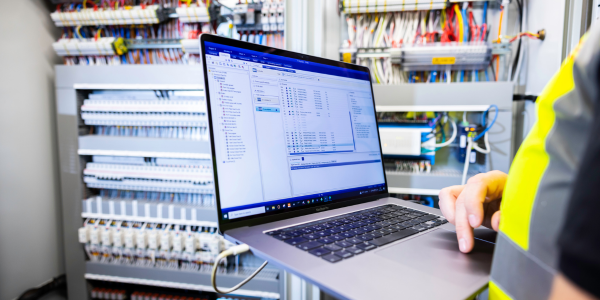The seamless interaction between various components is crucial for achieving optimal performance in any Building Management System (BMS). Effective interoperability among sensors, controllers, actuators and software ensures efficient management of heating, lighting, security and energy systems. This blog will delve into each of the key software and hardware components, as well as specialised components for HVAC (Heating, Ventilation and Air Conditioning), lighting and fire safety systems to illustrate how their integration enhances overall building efficiency.
Key components of Building Management Systems
Building Management Systems are composed of both software and hardware components that work together to manage and control a building’s environment efficiently.
Key software components allow for seamless interaction between different building systems such as HVAC, lighting and security. They consist of:
- user interfaces
- data management systems
- integration software
- security and access control
- energy management software
Hardware components of building management systems play a vital role in collecting and transmitting data throughout the building. They include:
- sensors and detectors
- controllers
- actuators and switched outputs
- communication devices
- networking infrastructure
How these components interact to manage a building effectively
These components work together to ensure a building operates efficiently. Sensors collect real-time data on temperature, air quality, occupancy and energy usage, which is then sent to the controllers. The controllers process this data and communicate with actuators and output devices to adjust settings, such as HVAC operation or lighting levels. Software components then analyse the data to identify trends, detect anomalies and make decisions on how to optimise the performance of the BMS. This interaction allows for real-time monitoring and control, leading to enhanced energy efficiency, occupant comfort and overall system reliability.
Software components of building management systems in more detail:
User interface
The user interface in a BMS enables operators to interact with and control various building systems. A user-friendly interface simplifies complex data and system controls, making it easier for users to monitor building performance and make informed decisions on how to optimise performance. Features of a user-friendly interface include intuitive navigation, real-time data visualisation, customisable dashboards and alert notifications.
Data management and analytics
Data management systems collect and store historical data to ensure that all relevant building information, such as energy usage and occupancy patterns, is accurately recorded. Advanced analytics tools process this data to identify trends, optimise building performance and reduce operational costs wherever possible. By leveraging BMS analytics, facility managers can make data-driven decisions to enhance energy efficiency and improve occupant comfort.
System integration
System integration involves connecting various building systems, such as HVAC, energy monitoring, lighting and security, into a single unified platform. This integration allows for seamless communication and coordination between systems, enhancing overall building management efficiency. This level of integration provides a comprehensive view of building operations and facilitates centralised control and automation.
Security and access control
Security and access control software solutions monitor and manage building security, with optional features such as surveillance integration, intrusion detection and emergency response management. Access control systems dictate who can enter or exit different areas of a building, offering benefits such as enhanced security, improved compliance with safety regulations and protection of sensitive areas.
Energy management software
Energy management software plays a key role in monitoring and reducing energy consumption within buildings. These tools provide insights into energy usage patterns, identify areas for improvement and implement energy-saving strategies. By contributing to sustainability initiatives, energy management software helps reduce carbon footprints and supports compliance with environmental standards.
Hardware components of building management systems in more detail:
Sensors and detectors
Sensors and detectors include temperature sensors, which monitor climate conditions; humidity sensors, which track moisture levels; occupancy sensors, which detect the presence of people in specific areas; and air quality sensors, which monitor gases, such as Carbon Dioxide, as well as the presence of particulates in the air. These sensors play a critical role in data collection, allowing the BMS to respond to changing conditions by adjusting systems, such as HVAC and lighting, to optimise comfort and energy efficiency.
Controllers
Controllers process data received from sensors and send commands to actuators. In a BMS, controllers manage operations, such as heating, ventilation and air conditioning. There are different types of controllers, including programmable logic controllers (PLCs) and direct digital controllers (DDCs), each designed to meet specific control requirements and ensure precise management of building systems. Controllers operate using bespoke operational software that is created to suit individual buildings and tasks.
Actuators and Switched Outputs
Actuators and switched outputs carry out the actions directed by controllers. They convert electrical signals into physical movements to adjust building systems. Examples of actuators include valves and dampers, which control the flow of water or air, and motors that operate fans and pumps.
Communication devices
Communication devices enable seamless communication and integration between sensors, controllers and actuators. They use a unique language that is understood by all the components and are used to send commands within the system. These are often referred to as ‘protocols’, with BACnet and Modbus being the most commonly used. They standardise data exchange and ensure interoperability between different systems and devices.
Networking infrastructure
Networking infrastructure connects all components of a BMS to enable centralised monitoring and control. This infrastructure can be wired or wireless, with each type offering specific benefits. Wired networks provide reliable, high-speed connections, while wireless networks offer flexibility and ease of installation, especially in retrofitting existing buildings.
Specialised components of Building Management Systems
HVAC management systems
HVAC management systems ensure optimal indoor climate by controlling temperature, airflow and air quality. Specific components include thermostats, air handling units and zone controllers, which work together to maintain comfort and energy efficiency.
Lighting control systems
Lighting control systems integrate with existing lighting systems to adjust brightness and timing based on occupancy and daylight levels. Key components include dimmers and occupancy sensors and timers, which contribute to improved lighting management and energy savings.
Fire and life safety systems
Fire and life safety systems include smoke detectors, fire alarms and sprinklers, all designed to detect and respond to fire emergencies. Integration with emergency systems, such as building-wide alert systems and evacuation controls, ensures a coordinated and effective response to fire incidents.
How the interoperability of Building Management System components enhances performance
Building Management Systems leverage both hardware and software components to optimise building operations. Key hardware components include sensors for data collection, controllers for system regulation, actuators for executing commands and communication devices for data exchange. On the software side, components such as user interfaces, data management systems and analytics tools enable efficient monitoring, control and optimisation of building systems. Together, these elements ensure effective management of HVAC, lighting, security, safety and energy systems, leading to improved performance, energy efficiency and occupant comfort.
Cube Controls is an established and experienced supplier of Building Management Systems, specialising in the design and set up of bespoke environmental and energy control programmes for commercial buildings and property.
To find out how Cube Controls can support you at all stages of design and consultancy, installation and modification and maintenance of your building management systems contact our expert and friendly team on 01903 694279 or sales@cubecontrols.co.uk.
Aceh4d
acehbola
aceh4d
slot online
slot online, acehbola
Agen Slot
aceh4d
slot bet 400
slot gacor online
Slot Online
acehbola
acehbola
Aceh4d Slot Big Win
lapak7d, toto slot
scatter hitam
Slot online
Situs Slot, togel online
scatter hitam
scatter hitam
scatter hitam
Situs Bet 100 perak
acehbola, situs slot online
acehbola, slot online
acehbola, Toto Togel
aceh4d, slot toto
Slot Gacor
Slot Gacor
Slot Gacor
Situs Bet 100 perak
Scatter Hitam
Parlay Bola
Acehbola
aceh4d
aceh4d
aceh4d, situs toto 4d
aceh4d, situs togel
Slot Gacor
Toto4d
Scatter hitam
Situs Bet 200 400 800 perak
acehbola, toto slot, agen togel
Tus4D, Situs Slot Online
acehbola, Slot Judi Bola
aceh4d, slot bet 200
tus4d, slot online, bandar togel
aceh4d, slot online, slot bet 100
aceh4d, slot toto
acehbola, Link Togel
acehbola, slot bet 200
aceh4d, slot online
acehbola, slot toto
aceh4d
aceh4d
aceh4d
tus4d, situs toto & togel 4d
aceh4d
acehbola
ksr88
aceh4d
aceh4d
acehbola
acehbola
acehbola, toto togel
acehbola
aceh4d
tus4d
acehbola
Agen Toto 4D
slot bet 200
terminal4d
#
acehbola, slot toto
Toto Slot
slot dana
slot bet 200 aceh4d
Bandar Togel Online
Slot gacor
Slot gacor
Slot gacor
Slot gacor
Slot gacor
Slot gacor
Slot gacor
Slot gacor
Slot gacor
Slot gacor
Slot gacor
slot gacor
slot gacor
slot gacor
slot gacor
slot gacor
slot gacor
slot gacor
slot gacor
slot gacor
slot gacor
slot gacor
slot gacor
slot gacor
slot toto togel
slot gacor
slot gacor
slot gacor
slot gacor
slot gacor
slot gacor
slot gacor
slot gacor
slot gacor
slot gacor
slot gacor
slot gacor
slot gacor
slot gacor
slot gacor
slot gacor
slot gacor
slot gacor
slot toto
slot gacor
slot gacor
slot gacor
slot gacor
slot gacor
SLOT ONLINE
Toto Slot
acehbola
aceh4d
slot toto
Aceh4d
slot gacor
slot gacor
Aceh4d
Acehbola, Agen Togel
Agen Slot Gacor
Slot Gacor
Slot Toto 4D
Slot gacor
Toto Bet 200
slot gacor
acehbola
situs bola
slot dana
toto slot
slot toto
Slot online
slot hoki
rtp slot gacor
slot dana
slot toto
Slot toto
situs slot dana
SLOT DANA
SLOT ONLINE
SITUS SLOT TOTO
SITUS SLOT ONLINE
situs bola online
judi bola




